裸眼 3D 显示关键技术研究
重庆大学硕士学位论文
(学术学位)
学生姓名:谭伟敏
指导教师:黄扬帆 教授
刘 然 副教授
专 业:电路与系统
学科门类:工 学
重庆大学通信工程学院
二 O 一四年四月
�
�
Research on Key Technologies of
Glasses-Free 3D Display
A Thesis Submitted to Chongqing University
in Partial Fulfillment of the Requirement for the
Master’s Degree of Engineering
By
Tan Weimin
Supervisor : Prof. Huang Yangfan
Assistant Supervisor: Associate Prof. Liu Ran
Specialty: Circuit and System
College of Communication Engineering of
Chongqing University, Chongqing, China
April, 2014
�
�
中文摘要
摘 要
近年来,随着 3D 显示技术的快速发展,3D 产品变得越来越流行。然而,目
前大多数的普通 3D 产品仍然需要观众佩戴特殊的眼镜,这严重制约了 3D 产品的
普及。为解决这一问题,裸眼 3D 显示技术应运而生,并受到广泛关注。
本论文的研究目的是通过对裸眼 3D 显示的关键技术进行研究,解决裸眼 3D
显示面临的内容制作和播放问题,为裸眼 3D 显示的应用提供理论和技术支撑。
论文首先介绍了裸眼 3D 显示原理,然后在该原理的基础上,对裸眼 3D 显示
的关键技术——裸眼 3D 内容制作和裸眼 3D 内容播放展开研究。在裸眼 3D 内容
制作方面,重点研究了基于 Autodesk® Maya 软件的裸眼 3D 内容制作方法和基于
深度图像绘制(depth-image-based rendering, DIBR)的裸眼 3D 内容生成算法;在裸
眼 3D 内容播放方面,提出了裸眼 3D 播放器的硬件架构,并给出了基于 DIBR 算
法以及多视图图像融合算法的硬件实现。论文意在获取高质量裸眼 3D 内容和裸眼
3D 播放效果的同时,降低算法的复杂性,以便硬件实现。
论文的主要研究成果包括:
① 根据shift-sensor摄像机设置的性质,分析并改进了基于DIBR的视图合成算
法,并研究了采用改进算法合成多视点视图的原理。改进后的算法和原算法相比,
合成新视点的图像质量相当,适合硬件实现。
② 介绍了基于 Autodesk® Maya软件制作裸眼3D 内容的方法。该方法采用
CelVision 3D Creator插件,通过设置参数、调整不同平面之间的距离,绘制得到8
幅具有视差的图像。该方法虽然复杂、耗时较长,但制作过程灵活,制作的裸眼
3D内容质量更高、3D效果更明显。
③ 提出了一种多视图图像融合算法。该算法首先对含有人眼视差的多幅视图
进行子像素抽取,然后按照光栅子像素排列规律进行排列,最后合成得到适合基
于光栅的裸眼立体显示器显示的合成图像。实验表明该算法可对8幅全高清视图进
行有效的融合,融合得到的合成图像适合于基于光栅的裸眼立体显示器显示,且
算法硬件实现简单。
④ 在FPGA开发板上,用较少的硬件开销实现了DIBR系统和图像融合系统。
相应地,给出了硬件架构、工作原理、时序图和仿真结果。
本论文力求在研究方法与思路上有所突破,其研究成果将为裸眼 3D 显示的应
用提供具有实用价值的新方法。
关键词:3D 显示,裸眼,图像融合,DIBR,FPGA
I
�
重庆大学硕士学位论文
II
�
英文摘要
ABSTRACT
With the rapid development of 3D display technology in recent years, 3D products
have become more and more popular. However, the most common 3D products require
users to wear special glasses, which has seriously limited the popularity of 3D products.
To solve this problem, glasses-free 3D display technology comes into being and has
been widely concerned.
The purpose of this dissertation is to solve the problems of content creation and
play facing glasses-free 3D display by researching on key technologies of glasses-free
3D display, which will provide the theoretical and technical support for the application
of glasses-free 3D display.
In this dissertation, the theoretical basis of glasses-free 3D display is firstly
introduced. Then, based on the theoretical basis, the key techniques of glasses-free 3D
display, glasses-free 3D content creation and play, are studied. As for content creation,
two glasses-free 3D content creation methods, the method based on Autodesk® Maya
software and the method based on depth-image-based rendering (DIBR), are thoroughly
studied; as for content play, a hardware architecture of glasses-free 3D player is
proposed. Moreover, the hardware implementation of DIBR and multi-view image
fusion algorithm is deliberated. This dissertation aims at achieving high quality of
glasses-free 3D contents and player effects with relatively low complexity of algorithms
which can facilitate hardware implementation.
The main research results of this dissertation are summarized as follows.
① According to the characteristics of shift-sensor camera setup, the view
synthesis algorithm based on DIBR is analyzed and improved, and the theory of
multi-view synthesis based on the improved algorithm is studied. Compared with
original algorithm, the improved algorithm can provide comparable image quality,
while it is facilitative for hardware implementation.
② A glasses-free 3D contents creation method based on Autodesk® Maya
software is introduced. This method can render 8 views using CelVision 3D Creator
plugin by setting parameters to adjust the distance between different planes. Although
the method is complex and time-consuming, it is flexible for content creation. In
addition, the quality of created glasses-free 3D contents is higher, and 3D effects are
better.
III
�
重庆大学硕士学位论文
③ A multi-view image fusion algorithm is proposed. Firstly, the algorithm
extracts sub-pixels from multi views which contain parallaxes, and then arrange these
sub-pixels in accordance with the sub-pixel arrangement rule for parallax barrier. Finally,
composite image is obtained which adapts to glasses-free 3D displays based on parallax
barrier. Experimental results show that the proposed approach can fuse 8 Full High
Definition (FHD) views effectively, and the composite image can be displayed on
glasses-free 3D displays based on parallax barrier. Moreover, this algorithm is easy for
hardware implementation.
④ The DIBR system and image composite system are implemented on a
development platform of FPGA with low hardware cost. Correspondingly, the hardware
architecture, operational principle, timing diagram and simulation results are also
presented.
As an original work, the author tried his best to make a breakthrough on research
methods and research thoughts, and the research results will provide new methods for
the practical applications of glasses-free 3D display.
Keywords: 3D display, Glasses-free, image fusion, DIBR, FPGA
IV
�
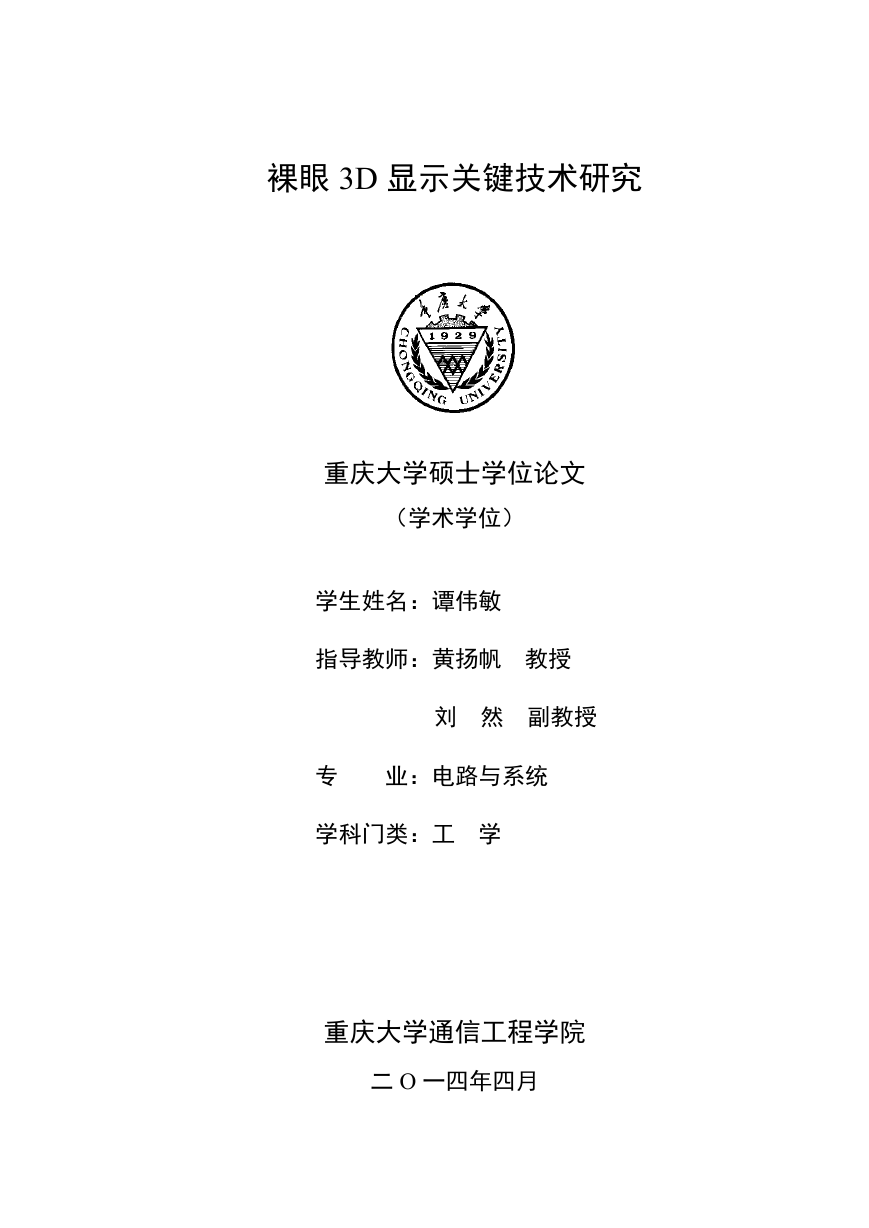

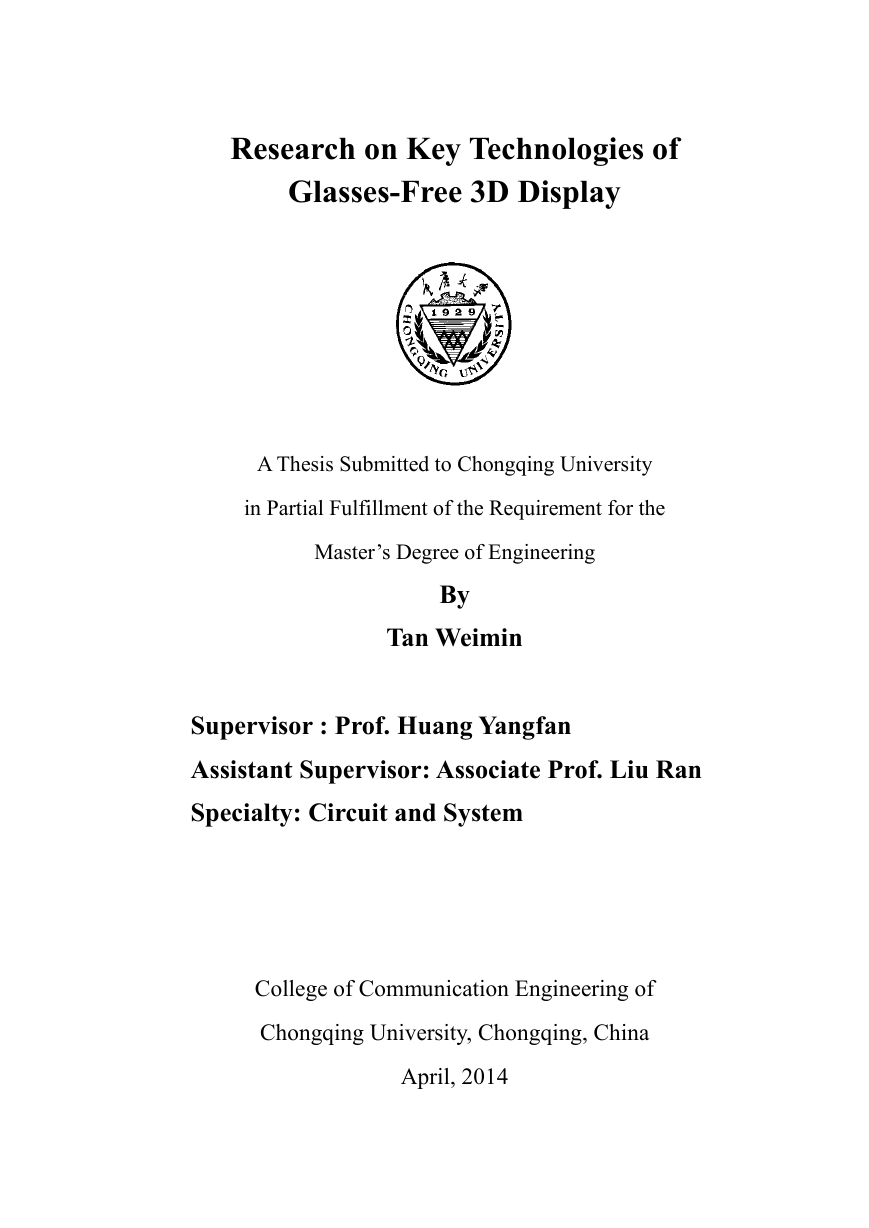

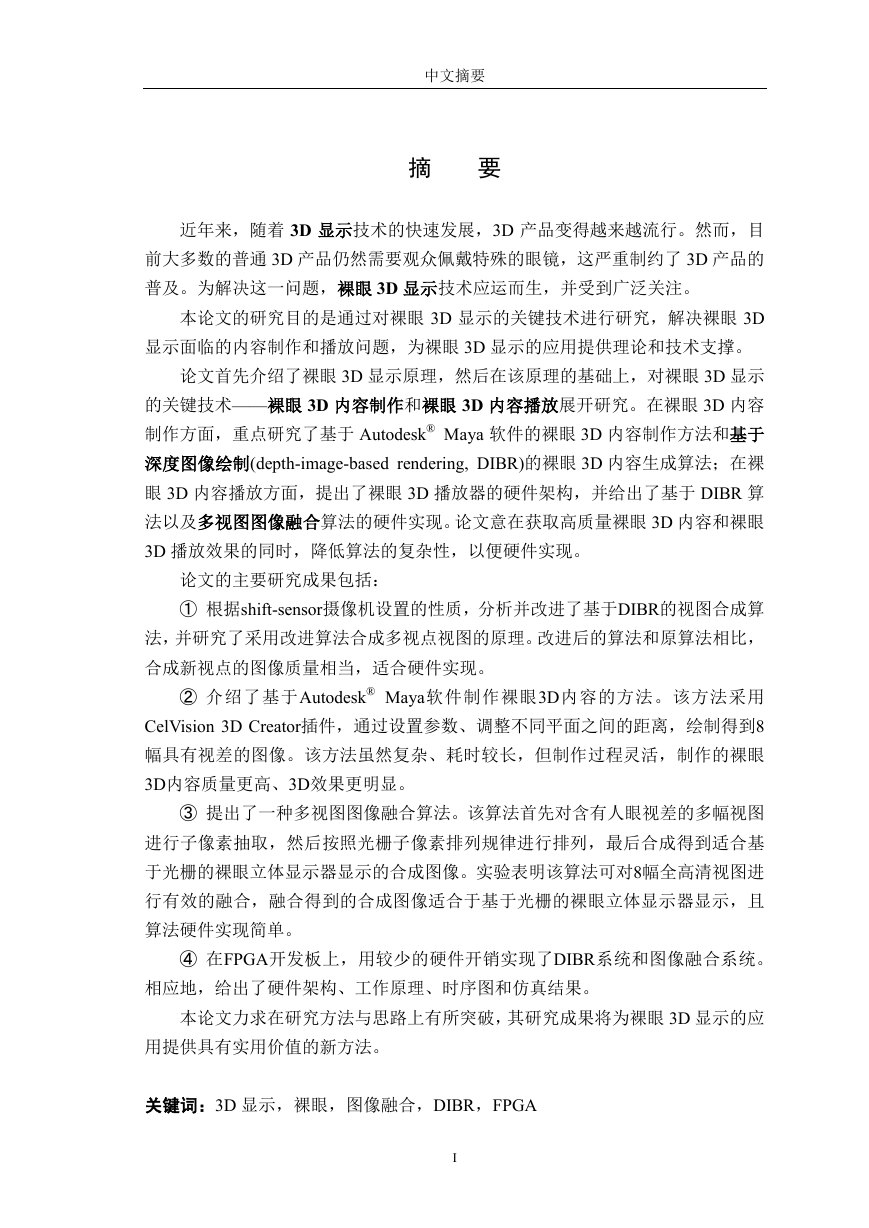

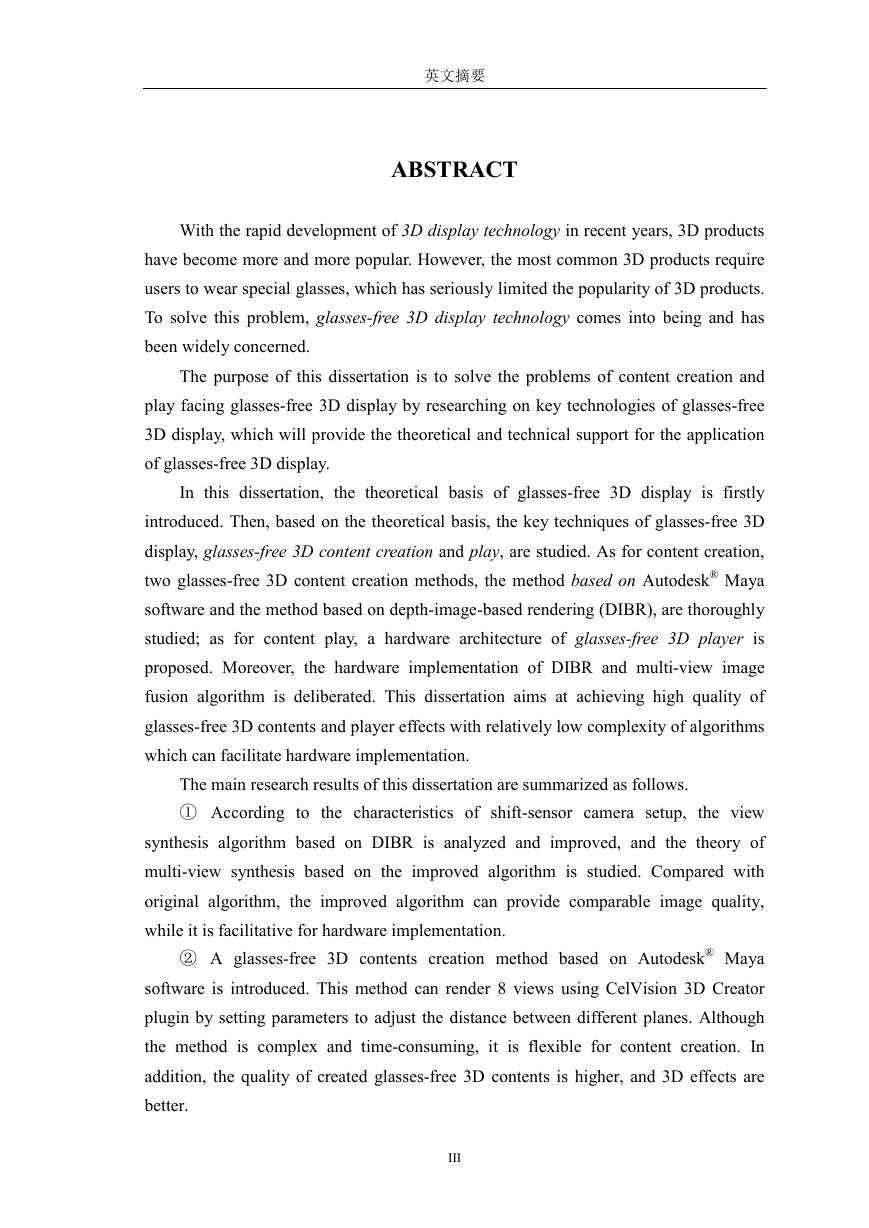
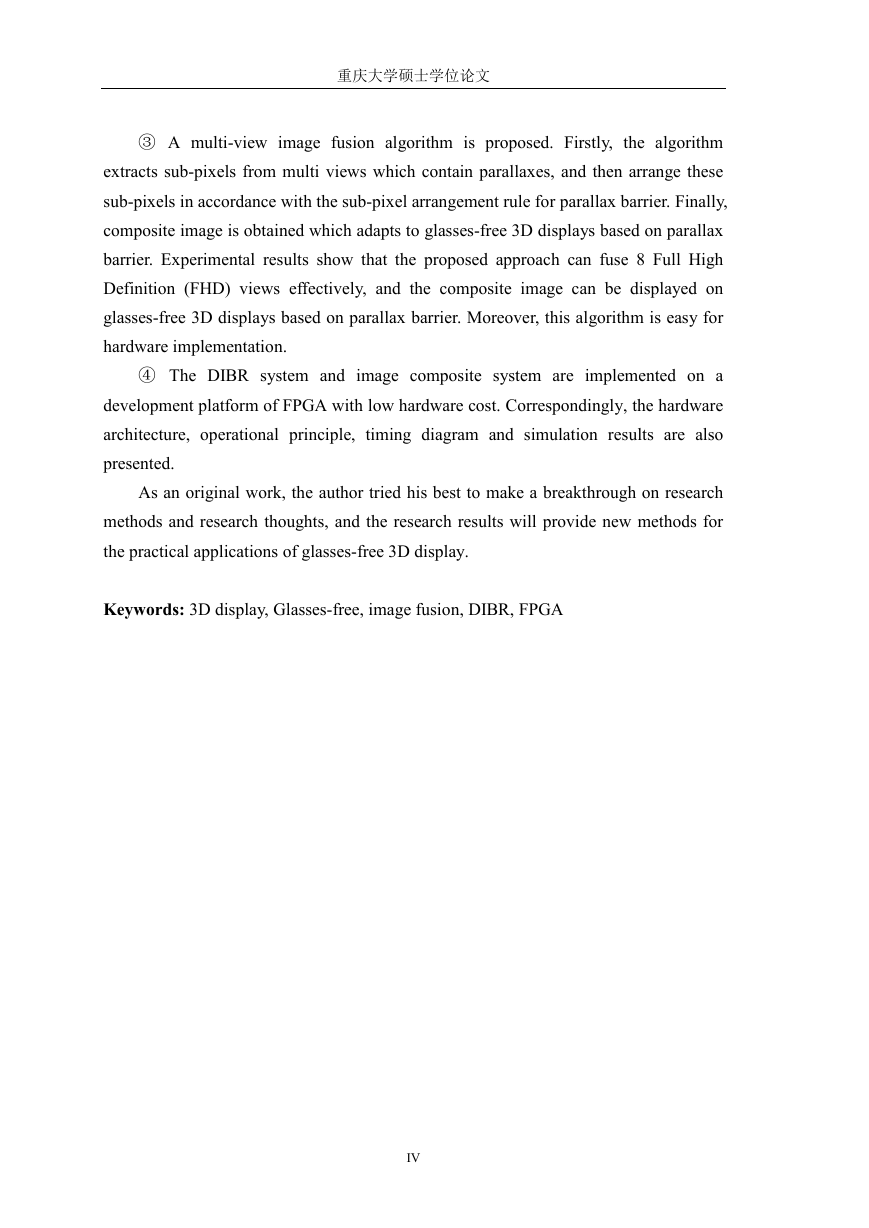








 2023年江西萍乡中考道德与法治真题及答案.doc
2023年江西萍乡中考道德与法治真题及答案.doc 2012年重庆南川中考生物真题及答案.doc
2012年重庆南川中考生物真题及答案.doc 2013年江西师范大学地理学综合及文艺理论基础考研真题.doc
2013年江西师范大学地理学综合及文艺理论基础考研真题.doc 2020年四川甘孜小升初语文真题及答案I卷.doc
2020年四川甘孜小升初语文真题及答案I卷.doc 2020年注册岩土工程师专业基础考试真题及答案.doc
2020年注册岩土工程师专业基础考试真题及答案.doc 2023-2024学年福建省厦门市九年级上学期数学月考试题及答案.doc
2023-2024学年福建省厦门市九年级上学期数学月考试题及答案.doc 2021-2022学年辽宁省沈阳市大东区九年级上学期语文期末试题及答案.doc
2021-2022学年辽宁省沈阳市大东区九年级上学期语文期末试题及答案.doc 2022-2023学年北京东城区初三第一学期物理期末试卷及答案.doc
2022-2023学年北京东城区初三第一学期物理期末试卷及答案.doc 2018上半年江西教师资格初中地理学科知识与教学能力真题及答案.doc
2018上半年江西教师资格初中地理学科知识与教学能力真题及答案.doc 2012年河北国家公务员申论考试真题及答案-省级.doc
2012年河北国家公务员申论考试真题及答案-省级.doc 2020-2021学年江苏省扬州市江都区邵樊片九年级上学期数学第一次质量检测试题及答案.doc
2020-2021学年江苏省扬州市江都区邵樊片九年级上学期数学第一次质量检测试题及答案.doc 2022下半年黑龙江教师资格证中学综合素质真题及答案.doc
2022下半年黑龙江教师资格证中学综合素质真题及答案.doc